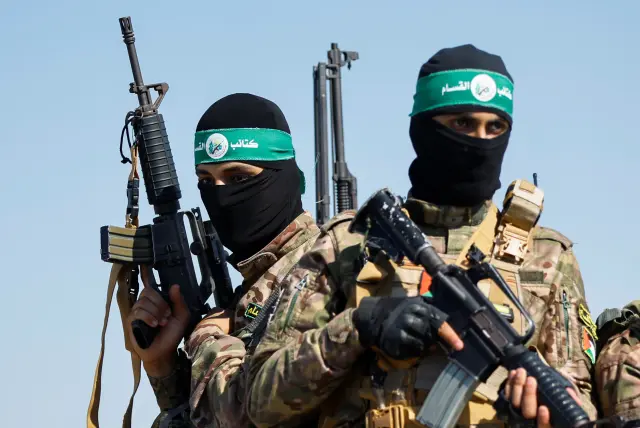
Recently I posed the question Hamas : What were they thinking? We now know the answer.
Evidence gleaned since Oct 7 shows Hamas militants prepared for a ‘second phase’ of assaults amid hopes of inspiring violence in the West Bank and beyond.
[…] In Beeri, a kibbutz town overrun by Hamas on Oct 7, one dead fighter had a notebook with hand-scrawled Quranic verses and orders that read, simply, “Kill as many people and take as many hostages as possible.” Others were equipped with gas canisters, handcuffs and thermobaric grenades designed to instantly turn houses into infernos.
Each was like a piece from a grisly puzzle, a snippet of fine detail from an operation that called for hundreds of discrete crimes in specific locations. Five weeks later, the reassembled fragments are beginning to reveal the contours of Hamas’s broader plan, one that analysts say was intended not just to kill and capture Israelis, but to spark a conflagration that would sweep the region and lead to a wider conflict.
The evidence, described by more than a dozen current and former intelligence and security officials from four Western and Middle Eastern countries, reveals an intention by Hamas planners to strike a blow of historic proportions, in the expectation that the group’s actions would compel an overwhelming Israeli response. Several officials who had not previously spoken about the matter said the intelligence about Hamas’s motivations has become stronger in recent days.
[…] As it happened, even Hamas was surprised by the sweeping nature of its incursion on Oct 7, according to the group’s public statements as well as assessments shared privately with journalists. But Hamas leaders expected that their assault would yield more than just hostages, current and former intelligence officials said.
A Hamas official, Basem Naim, asserted in an interview Friday that the group planned in advance for a severe Israeli retaliation. He cited recent events, such as Jewish settler attacks against Palestinians in the West Bank and the storming of Jerusalem’s al-Aqsa Mosque by settlers, as fueling Palestinian rage.
“We knew there was going to be a violent reaction,” Naim said. “But we didn’t choose this road while having other options. We have no options.”
Hamas meticulously planned and prepared for a massacre of Israeli civilians on a scale that was highly likely to provoke Israel’s government into sending troops into Gaza, analysts said. Indeed, Hamas leaders have publicly expressed a willingness to accept heavy losses – potentially including the deaths of many Gazan civilians living under Hamas rule.
[…] Hamas was willing to accept such sacrifices as the price for kick-starting a new wave of violent Palestinian resistance in the region and scuttling efforts at normalizing relations between Israel and Arab states, according to current and former intelligence officials and counterterrorism experts.
“They were very clear-eyed as to what would happen to Gaza on the day after,” said a senior Israeli military official with access to sensitive intelligence, including interrogations with Hamas fighters and intercepted communications. “They wanted to buy their place in history – a place in the history of jihad – at the expense of the lives of many people in Gaza.”
In other words, they wanted to be martyrs.
[…] The ultimate supplier of the weapons was unclear, but analysts said the goods crossed into Jordan with the aid of Iranian-backed militias in Syria and Iraq, two countries that share a border with the kingdom. How many weapons successfully reached the West Bank is unknown, they said. At least some of the drones were equipped with anti-jamming equipment that made it difficult to force the aircraft down, one of the officials said.
[…] Naim, the Hamas official, said the group’s unwavering position on reclaiming all former Palestinian lands should have made its intentions clear. Hamas acted out of a conviction that “we are being erased – our cause is being erased.”
“We warned, we said something is coming, we said, don’t bet on the Palestinians’ silence,” Naim said. “No one listened. This operation, we consider it an act of defense. I am besieged in a prison; I tried to break out of the prison.”
Which is basically the position of pro-Palestinians everywhere – Hamas were forced into it. Just like if someone were to break out of a real prison and go on a murder spree to draw attention how bad being in prison is. Totally understandable. /sarc
[…] However, Hamas officials have said repeatedly that they did expect – and welcomed – an extensive Israeli retaliation. Spokesman Ali Barakeh, reached by phone in Lebanon as the Israeli ground campaign was beginning, said Hamas had prepared itself for Israeli bombs and believed it could also repel an IDF ground assault from defensive positions linked by a latticework of tunnels.
“They can thwart it,” Barakeh said of Hamas’s forces. Referring to Israeli ground operations, he said: “Land is easier for us. Let them come attack by land. We are ready.”
[…] Hamas’s pronouncements welcoming a broader conflict evoke statements by al-Qaeda leaders in the aftermath of the Sept 11, 2001, attacks, noted Rita Katz, executive director of the SITE Intelligence Group, a private organization that studies the ideology and online communications of extremist groups. Al-Qaeda leader Osama bin Laden expected a furious American response after the attacks on New York and Washington, Katz said, and he welcomed what he believed would be a violent, global confrontation between the Muslim world and the West, with Islam ultimately prevailing.
“Hamas knew Israel would strike back hard. That was the point,” Katz said. “To Hamas, Palestinian suffering is a critical component in bringing about the instability and global outrage it seeks to exploit.”
The aim to cause as much chaos and as big a response as possible is nothing new. As mentioned above we have Bin Laden and 9/11 as an example. On a much lesser scale there’s Charles Manson, whose aim was to provoke enough outrage to start a race war.
Neither succeeded, of course, because to do evil in order to provoke a retaliatory response by a much larger opponent is a losing strategy. All it does is increase resolve of the opponent.
But what about the hundreds of thousands, maybe millions, of pro-Palestinian supporters you ask? So what. It’s not a numbers game. Israel is in the right. For Hamas to commit such an evil act of terror on such a scale automatically puts Hamas in the wrong.
Which is another reason they will never win.








